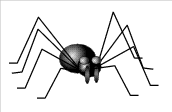


abdomen: The rear section of the spider where the heart, liver, lungs, and silk-producing glands are found.
arachnid: Any animal that has eight legs, two body parts and no backbone, wings, or antennae. Spiders, scorpions, ticks, and mites are members of this group.
cephalothorax: (sef ah low THOR ax): The front section of the spider that has the eyes, brain, and jaws. The legs are attached here.
exoskeleton: All spiders have this hard outer shell that covers and protects their bodies. It does not grow.
eyes: Most spiders have four pairs of eyes (one main pair and three smaller pairs); however, some species have fewer. Few spiders see well.
legs: All spiders have four pair of legs: two pairs facing front and two pairs facing back. The hairs on a spider's legs pick up vibrations and smells from the air. At the end of each leg are two or more tiny claws.
molt: As a spiderling grows, its exoskeleton becomes tight and eventually cracks open. When the young spider sheds this outer layer, it has molted.
palps: These leg like limbs at the sides of the spider's jaws serve as feelers. Spiders also use them to hold, taste, and crush their prey.
spiderling: a baby spider
spinnerets: Openings on the undersides of a spider's abdomen (at the rear) where silk is released.